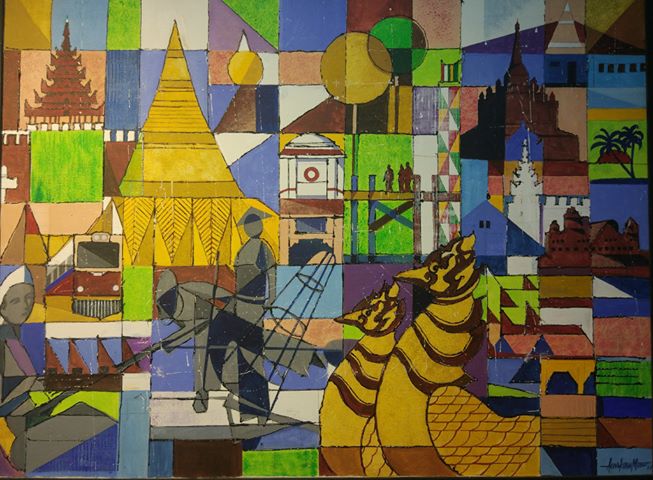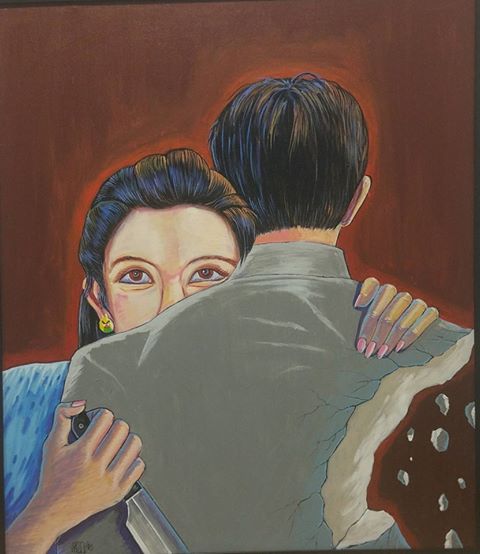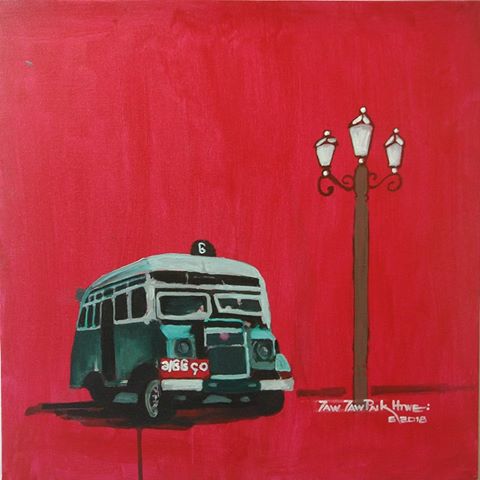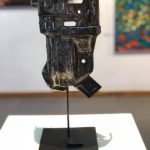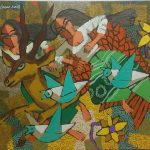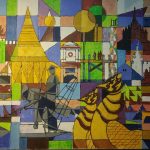The Irrawaddy Magazine |
- TNLA Puts Abducted Shan Woman ‘on Trial’
- Lawmaker Demands Accounting of Dam Maintenance Funds after Bago Flood
- Hidden History: Century-Old Monasteries in Mandalay
- Myanmar Slides on Global Rule of Law Index
- Local Condemnation for Reuters Journalists’ Verdict
- Karenni Govt Orders CSOs to Provide 2 Weeks’ Notice of Meetings
- Veteran Artists Team Up with Younger Generation at ‘Wild Eye’ Exhibition
- China Complicit in Blocking Aid to Kachin Refugees: Report
- Yangon Animal Shelters Required to Apply for Licenses
- Myanmar Army Apologizes for Mistaken Photos in Book on Rohingya Crisis
- Ten Things to Do in Yangon This Week
- Thai King’s Yellow and Blue Volunteers Boost His Support, Visibility
- Asia’s Rising Appetite for Meat, Seafood Will ‘Strain Environment’
| TNLA Puts Abducted Shan Woman ‘on Trial’ Posted: 04 Sep 2018 06:07 AM PDT CHIANG MAI, Thailand — The Ta'ang National Liberation Army (TNLA) said on Monday it had put on trial a Shan woman whom it took from her home at gunpoint last month in Namhkam Township, northern Shan State. Nang Mo Hom is being tried in the TNLA's central court for allegedly obstructing its troops as they performed their duties, the group said. Five TNLA troops arrested Nang Mo Hom at gunpoint on Aug. 17. Since then she has not been able to meet her family, despite demands for her release by local civil society groups. A Shan political party, the Shan Nationalities League for Democracy (SNLD), on Aug. 27 sent a letter to State Counselor Daw Aung San Suu Kyi requesting that she intervene, in her capacity as the head of the National Reconciliation and Peace Center (NRPC), to assist Nang Mo Hom. The TNLA said in a Sept. 3 statement that Nang Mo Hom had been charged under its own authority with obstructing its troops as they attempted to collect customs duties, and that her actions had resulted in the death of one of the officers. TNLA spokesman Mai Aik Kyaw told The Irrawaddy on Tuesday that the Palaung State Liberation Front (PSLF)/TNLA court would hear the case against the woman, who was charged by the group under Article 333 of Myanmar's Criminal Code. When it came time to hand down a verdict, the spokesman said, the TNLA court "would try to make it a public hearing held before members of the public, including the family of the woman." He did not say when the verdict was expected. Mai Aik Kyaw said Nang Mo Hom had committed a crime under the law as enforced by the TNLA. He was referring to an incident in July 2017 when two TNLA soldiers were attacked by the Myanmar Army for allegedly extorting money from local businesses in Namhkam Township. Relatives of Nang Mo Hom said the TNLA had been extorting money from them for two years until July 2017, when one TNLA soldier was shot dead and another arrested and imprisoned in Lashio Prison after demanding 1 million kyats from the family. The TNLA's announcement on Monday raised eyebrows, with observers asking how an organization that itself operates outside the country's laws could justify putting a woman on trial for breaking "its laws". Addressing this point, Mai Aik Kyaw said, "As we are an armed group and not a ceasefire group, we cannot seek justice at the official township court." Therefore, they arranged their own justice, he said. "The hearing is ongoing. On the day of the verdict we will invite her [Nang Mo Hom's] family and relatives to attend," he told The Irrawaddy. SNLD spokesman Sai Leik raised doubts about the legitimacy of the move. "The question is whether they have the legal and judicial authority," Sai Leik said, adding that, as the TNLA's administration lacks legitimacy, "how can we acknowledge their judgment?" "We do not recognize their judiciary, which is illegal and run by an illegal organization," Sai Leik said, adding that the SNLD, as a registered political party, cannot directly communicate with TNLA and had therefore sought the NRPC's intervention. However, the NRPC is unlikely to be able to intervene in the case. As with most affairs in conflict-torn Shan State, such issues usually require the involvement of the armed forces, on both the government and the ethnic groups' sides. Sai Leik told The Irrawaddy the NRPC had not responded to their request yet, though it was submitted over a week ago. The Irrawaddy was unable to contact NRPC vice chairman Dr. Tin Myo Win, who is also chairman of the Peace Commission and the government's chief negotiator with the ethnic armed organizations. Other members of the commission contacted by The Irrawaddy declined to comment. Sai Leik called for an end to the fighting in Shan State, especially in the north, saying the TNLA and its allies had deliberately turned the area into a "war zone" in order to protect their interests. "If things are allowed to develop in that direction, the chances of peace will get more remote, and this only harms the public, and social tensions between the ethnic groups will only escalate," the SNLD spokesman said. Since the TNLA's abduction of the Shan woman, a war of words has erupted among Facebook users supporting either the Shan or Ta'ang, who accuse each other's armed forces of human rights violations. It is hard to verify whether individual social media users are actually Ta'ang or Shan, however. Ta'ang National Liberation Army, Shan State, abductions, extortion, communal conflict The post TNLA Puts Abducted Shan Woman 'on Trial' appeared first on The Irrawaddy. |
| Lawmaker Demands Accounting of Dam Maintenance Funds after Bago Flood Posted: 04 Sep 2018 05:22 AM PDT NAYPYITAW—Lawmaker U Tin Tun Naing grilled the Ministry of Agriculture, Livestock and Irrigation about last week's fatal dam burst in Bago Region, during Monday's session of the Union Parliament. The lawmaker expressed doubts that the ministry had conducted the proper annual maintenance work on the dam. At least seven people were killed after the dam on Swar Creek in Bago's Taungoo District was breached on Aug. 29. "This shows that annual maintenance work was not carried out," U Tin Tun Naing told reporters on Monday during a break in the parliamentary session. Parliament was meeting to discuss the national planning bill for fiscal 2018-19. The lawmaker claimed that an average of around 70 billion kyats was allotted annually from the government budget to maintain dams and reservoirs across the country. For fiscal 2018-19, 69 billion kyats had been allocated for the purpose, he said. "So after the Swar Dam incident, there is a question. Is that money being used properly — is it really being used for maintenance work?" he asked. When asked to comment on the issue by The Irrawaddy, Agriculture Ministry deputy permanent secretary U Myo Tint Tun said the ministry conducts regular maintenance on the dam, but the spillway had been unable to withstand "unusual" rainfall. "Unlike previous years, it was submerged under nearly 2 feet of water this year. The spillway could not bear the weight and burst," he said. According to statistics issued by the Ministry of Social Welfare, Relief and Resettlement on Aug. 31, seven people were killed, three are still missing and more than 5,000 residents of Yedashe, Taunggu, Oktwin and Kyauk Gyi townships in Taungoo District were affected by flooding of the Sittaung River after the bursting of the dam. Yedashe Township was hardest hit, with 185 houses completely destroyed. More than 300 houses and 10 monasteries were damaged. The flooding also damaged parts of the Swar Creek Bridge on the Yangon-Mandalay Expressway, as well as the old Yangon-Mandalay road and the railroad between the cities. Lawmaker U Tin Tun Naing asked the ministry to disclose its maintenance expenses for the Swar Creek Dam over the past five fiscal years. Concerned ministers will be required to answer lawmakers' questions after they finish discussing the national planning bill for fiscal 2018-19. The post Lawmaker Demands Accounting of Dam Maintenance Funds after Bago Flood appeared first on The Irrawaddy. |
| Hidden History: Century-Old Monasteries in Mandalay Posted: 04 Sep 2018 05:12 AM PDT YANGON — Mandalay is one of Myanmar's most culturally rich cities and home to a number of listed historic monasteries, some of which are over 100 years old and remain in good condition as an example of ancient architecture. There are some well-known monasteries that are already popular with tourists in Mandalay and can become quite busy. To avoid the well-visited monasteries and take in the designs in peace and quiet, you can visit these monasteries which are less well-known but still beautiful. Second Shwe In Pin Monastery There are a total of three monasteries in the Shwe In Pin collection in Mandalay and this one is technically called 'Second Shwe In Pin Monastery' but people know it as simply 'Shwe In Pin'. It is located on 89th Street between 37th and 38th streets in Maha Aung Myay Township. 
The monastery is 123 years old and it was built by two wealthy Chinese merchants. While the compound of the monastery is really big, the entrance is a bit small so look carefully as it is easy to miss. Once you enter the monastery compound, you have to take off your shoes. Even in the morning, the compound is peaceful and quiet. After walking a few steps, you'll see the big, beautiful Shwe In Pin Monastery standing impressively before you. The whole monastery is made entirely of teak wood. The roof of the monastery was built in tiers and the entrances of the building, walls, windows, doors are decorated with engravings. These engravings feature beautiful figures of people, dragons, birds, nats (spirits), flying horses and some flying humans too. All of the lines were created with a lot of detail giving it a unique elegance. It is really impressive ancient architecture. The monastery was made using a total of 156 marble columns and the structure was originally four large separate rooms connected by a walkway. It has a total of eight gates (the entrances are designed like gates) but some of them are really worn and not open. Visitors can go into the main monastery hall through a number of open gates. Be careful with your step because the teak floors are really old and might be weak. In the hall, there is a big Buddha statue and some monks still worship here. The whole building is beginning to deteriorate and needs restoration works as soon as possible. As a whole, the details of the design were just mind-blowing and I couldn't say anything except "It's so beautiful." I recommended you see it with your own eyes while you are in Mandalay. Mahar Min Htin Monastery Mahar Min Htin Monastery was donated by Mahar Minla Minkyaw U Min Htin in 1852. It is 165 years old and located near the famous Maha Muni Pagoda in Maha Aung Myay Township.  This monastery was originally built at Ava (now called Inwa) in 1852 and was moved to Mandalay in 1876. In the beginning, the monastery was built with a total of 426 teak columns but only 143 of them are left since its relocation. This means the original structure in Ava was probably three times bigger than what we see today. New wood columns have replaced the empty spots. The monastery is famous for its huge size, ancient architectural design and a few engravings. It is uniquely set surrounded by three small moats. It has two main entrances but can only be entered through one as the other is badly damaged. Many parts of this monastery are damaged and have to be restored as soon as possible by architects specializing in historic design. Kyay Myin Monastery Kyay Myin Monastery is another wooden one and has been standing for 140 years. It is located on 62nd Street and the entrance is at the end of a narrow lane off the street.  The original owner was the Yanarpo Ywar Sar but it was restored by King Mindon's queen named Queen Kyay Myin so people have been calling it Kyay Myin Monastery. The monastery's roof is three-tiered and the kinnara and kinnari (mystical half-human half-bird couple), belu (ogre) engraving works on the entrance stairs are really impressive and surely the highlight of the monastery.  It is still in use and monks are living in the building. Visitors can go inside and see some old furniture styles of the previous century as well as some sculptures. This one is also a worthy place to visit when in town. Kin Wun Min Gyi Monastery This large wooden monastery was built in 1879 by Kin Wun Min Gyi U Kaung. It is located in East Daywun Quarter in Maha Aung Myay Township.  U Kaung was a chief minister during the reigns of King Mindon and Thibaw. During King Mindon's reign, he visited Europe and went to cities across England, France and Italy as an ambassador. This European trip inspired the design he used for Kin Wun Min Gyi Monastery and has made the building famous to the present day. It is one of the only monasteries in a Western style of the 18th and 19th centuries and doesn't have the usual tiered roof. The building is now closed and no longer in usable condition but you can ask for the key from the monks who stay in the building compound and observe the interior structure and artwork.  The interesting parts of this building are its huge dimensions and the use of tall wooden pillars. Some parts of the building have been damaged over time but some ancient engraving work still remains. The inside of the monastery is really dusty but the spiral stairs and big doors are beautiful. Pyi Min Thar Monastery Pyi Min Thar Monastery is similar to the monastery mentioned above, with a few ancient engravings at the stair entrance. It still used by the monks.  The special things about this monastery are the many ancient Buddha statues and historical artifacts kept here. There are ornamental thrones and their backdrops, book cabinets, lacquer boxes, teak boxes with Jataka inscriptions, packs of palm-leaf inscriptions, gilded glass mosaics, ancient brass bells and traditional art depicting lotus buds. Mostly, the door is kept closed by the monks but you can ask them to study the things inside. This is a great place to observe some of Myanmar's historic Buddha statues and other ancient artifacts.  It was built in 1839 by the Prince of Pyi, and the 179-year-old monastery can be found near 78th Street. The post Hidden History: Century-Old Monasteries in Mandalay appeared first on The Irrawaddy. |
| Myanmar Slides on Global Rule of Law Index Posted: 04 Sep 2018 04:58 AM PDT YANGON — Myanmar dropped two places in a global rule of law index from last year, leaving the country second lowest in the East Asia and Pacific region. According to the Washington-based World Justice Project's 2017-2018 report, Myanmar ranked 100th among 113 countries globally and 14th among the 15 countries in the East Asia and Pacific region included in the index. Serious corruption in the legislature, executive branch, police, military and judiciary contributed to the low ranking, according to the report. The WJP Rule of Law Index 2017-18 presents a snapshot of the rule of law in 113 countries by providing scores and rankings based on eight factors: constraints on government powers; absence of corruption; open government; fundamental rights; order and security; regulatory enforcement; civil justice; and criminal justice.
Myanmar fared badly in all eight categories; out of the 113 countries, it ranked 107th in open government, 110th in fundamental rights, 109th in civil justice, and 107th in criminal justice. Among the 15 countries in the region, Myanmar's fundamental rights ranking was 15th, while it ranked 14th in terms of civil justice, criminal justice and open government.
The report cited limits on the legislature and judicial system as the main areas in which government powers are constrained in Myanmar. Corruption, a lack of effective investigations and slow and ineffective adjudication are main reasons for the weakness of the criminal justice system, it said. Crime, civil conflict and violent redress are the major causes for the lack of order and security in the country, the report found. The country scores and rankings used to compile the rule of law index are derived from more than 110,000 household surveys and 3,000 expert surveys conducted globally, according to the World Justice Project. The post Myanmar Slides on Global Rule of Law Index appeared first on The Irrawaddy. |
| Local Condemnation for Reuters Journalists’ Verdict Posted: 04 Sep 2018 04:46 AM PDT MANDALAY — Nine Myanmar journalist networks issued a joint statement on Tuesday condemning the verdict of the two Reuters reporters and urging the government to do everything possible to achieve justice. The statement said that since the reporters were framed and unjustly sentenced to seven years in prison, the government must act in accordance with the law and serve justice, as the verdict is a threat to press freedom. "The government must do everything they can according to the law for the justice of the jailed Reuters reporters and promote freedom of press which is dramatically declining," said the statement. The statement also said that press freedom is declining under the governance of the ruling party, the National League for Democracy, as since they took up office in April 2016, there have been a series of lawsuits against news agencies and journalists causing fear in journalists who are doing their job. "In the face of the international community, Myanmar has become a country where the standard of press freedom is declining and the government should see this as a threat which affects the country's transition towards democracy," said the statement, highlighting the verdict of the two Reuters reporters under the Official Secrets Act on Monday. The statement was signed by the Myanmar Journalist Network, Myae Latt Journalist Network, Magway Journalist Network, Taunggyi Journalist Association, Chin Media Network, Southern Myanmar Journalist Network, MJN (Ayeyarwaddy), Myanmar Women Journalists Society and Monywa Journalist Network. The Myanmar Press Council (MPC) also issued a statement on Tuesday, saying the sentencing of the two journalists neglects the Constitution and existing media laws. "Sentencing the Reuters reporters with a 1923 colonial-era law, which cruelly oppresses journalists, is neglecting the Constitution and the existing media laws," said the statement from MPC. "This incident not only affects the right to information but also the flow of information to the people, which could seriously affect the image of the country," the statement added. News of the verdict has become headline news for many local media outlets and sparked disappointment and sadness among journalists across the country. On Tuesday, nearly every privately-run newspaper in Myanmar made the Reuters case front page news. The 7Day Daily newspaper also showed its solidarity with the jailed reporters by putting a black column at the center of the front page of the Tuesday issue. However, this was not the case for state-owned papers: the story was tucked inside the three newspapers published by the Ministry of Information. Many local journalists showed their solidarity and disappointment by changing their Facebook cover photos and profile pictures to those of the two reporters, Ko Wa Lone and Ko Kyaw Soe Oo, featuring the text 'Journalism is not a Crime' or 'Free Wa Lone and Kyaw Soe Oo.' Journalists in Mandalay and Pyay took to the streets to show their solidarity with the reporters. In Mandalay, about 30 local journalists wearing black got together and went to Maha Muni Pagoda to pray for the release of the jailed reporters on Monday. In Pyay, on Tuesday, demonstrators held a campaign expressing their condemnation of the sentencing of the two journalists and urging the government to free them immediately. It was led by local journalists with the participation of political activists and university students. Meanwhile, journalists across the country are collecting signatures for a petition that will be sent to President U Win Myint calling for the immediate release of the reporters. They expect to gather 20,000 signatures from across the country from journalists, political activists and other people who want justice and freedom of the press. The post Local Condemnation for Reuters Journalists' Verdict appeared first on The Irrawaddy. |
| Karenni Govt Orders CSOs to Provide 2 Weeks’ Notice of Meetings Posted: 04 Sep 2018 03:54 AM PDT The Karenni State government ordered non-governmental organizations, international non-governmental organizations and community-based organizations to provide two weeks' notice of any meetings or workshops they planned to hold in the region. A statement issued by the regional government on Aug. 30 read that NGOs, INGOs and CBOs must inform township authorities two weeks prior to holding any meetings or workshops. It stated that following meetings, the groups must write a brief summary of the outcomes to send to concerned government ministers. The Irrawaddy reporter tried to get a comment from the Karenni State chief minister, who replied that he would respond in person but not comment over the phone. Many right activists including NGO and INGO workers criticized the statement, adding that it was not a democratic standard. "The government wants to know all of the activities held by these groups. Their order does not uphold democratic standards," said Kyaw Htin Aung, the director of the LAIN Technical Support Group, which assists rights groups holding meetings in Loikaw. Many civil society organizations (CSOs) in Karenni State use religious buildings or schools to hold meetings, as they do not have the budget to rent space elsewhere. These CSOs will face difficulties if they are forced to seek permission two weeks in advance of any meetings. Rights activists say the state government began restricting their efforts in May of last year, when they were told they needed to seek permission 10 days before any events. The government did not take serious action if this was not adhered to in the past. After Karenni youth held a protest against the state government's project to construct a General Aung San statue in Loikaw, the government appeared to tighten its restrictions, said Khun Bernard, the general secretary of the Kayan New Generation Youth. He said that if the government found the group's meetings threatening, it could take action. "But our meetings are to work toward peace," he added. Khun Bee Du, chairman of the Kayan National Party, said the state government also told people they were not allowed to protest in front of the regional parliamentary building or the Myanmar Army regional operations command base in Loikaw. "I feel that they acted above the law," he said. "It is time for the government and CSOs to cooperate." The post Karenni Govt Orders CSOs to Provide 2 Weeks' Notice of Meetings appeared first on The Irrawaddy. |
| Veteran Artists Team Up with Younger Generation at ‘Wild Eye’ Exhibition Posted: 04 Sep 2018 03:22 AM PDT YANGON — Veteran modernists and younger generations have teamed up to exhibit their works together in Yangon. Twenty-seven modernists are displaying more than 50 works at "Wild Eye" contemporary art exhibition at OK Art Gallery in Aung San Stadium. Their works are either of purely artistic creation or they reflect the contemporary history of their time.
Viewers find a painting of a woman boxer with three boxing gloves, one on her head, captivating. "Those three boxing gloves represent luck, brain and industry, and the boxing ring is life. I mean to say that people should make use of luck, brains and hard work to win in life," said veteran surrealist San Min. "Angry Love" depicts the angry eyes of a woman who is about to stab her lover in the back. "This painting is about the dark side of technological advancement," San Min said.
Advanced technologies have provided people with easier access to communicate with each other, but also made it easier for people to cheat on their spouses, leading to social problems, he added. In his "Unknown Rope, Marriage Knot," young surrealist Ye Min put chains in the place of the heads of a bridegroom and bride. Artist Than Htay used only black and green colors in his abstract painting. "In this painting, I've reduced colors and focused on speed."
"Wild Eye" is a regular art exhibition held since the 1970s by modernists. The exhibition will be held through Sunday and paintings are available for prices between US$500 and $5,000. The works of Kin Maung Yin, Win Pe, Aung Myint, San Min, Ye Min, Ohn Khaing Zin, K2K are more are on display at the exhibition. The post Veteran Artists Team Up with Younger Generation at 'Wild Eye' Exhibition appeared first on The Irrawaddy. |
| China Complicit in Blocking Aid to Kachin Refugees: Report Posted: 04 Sep 2018 02:52 AM PDT YANGON — A rights group's report has claimed Chinese involvement in the Myanmar government's blocking of humanitarian assistance to war refugees on the Myanmar-China border where government troops and Kachin armed groups have been fighting. "China made their position particularly explicit that humanitarian aid organizations should not be provided access to displaced populations on the Myanmar-China border, equating these organizations with 'western' powers—namely the United States government," a recent Fortify Rights report said. The report said that since the previous government organized peace-talks between Myanmar's military and ethnic armed groups, Chinese representatives in the meetings reportedly insisted that aid organizations not operate on the border areas in Kachin State. A new report "They Block Everything" based on 195 interviews in Kachin state over the last five years [2013-2018], revealed how Myanmar authorities—particularly the military—have weaponized the denial of humanitarian aid in Kachin State for years. It claims China plays a role in helping Myanmar authorities to put aid restrictions on Kachin refugees. Since 2011, when armed conflict between the Myanmar military and the Kachin Independence Army (KIA) resumed, the Myanmar government and military restricted access for humanitarian organizations to refugees in Kachin State especially access to internally displaced persons (IDP) camps in KIA-controlled areas. An estimated 120,000 people have been displaced from their homes since 2011 due to the armed conflict in Kachin State. There are 140 IDP camps in Kachin State and 40 percent of displaced people are living in areas controlled by the KIA and related groups. According to the report, from June 2017 to June 2018, the government of Myanmar approved approximately five percent of 562 applications for travel authorization to government-controlled areas by international humanitarian organizations. Since 2015, some aid workers have reported government-imposed restrictions on particular types of aid, including medical supplies. As a result of the restrictions, local humanitarian aid workers rely on suppliers in China to obtain aid for the estimated 40,000 IDPs residing on the Myanmar-China border, the report said. The report also says all activities in China relating to the IDPs are unofficial, while transporting aid over the China border presents a high risk of being arrested by the Chinese authorities. Mostly, aid workers have to avoid checkpoints, as China has increased patrols and checks for transporting humanitarian aid to the Kachin refugees. Chinese suppliers also face risk, particularly when authorities perform surprise checks of their offices. Mary Tawn, a director of local relief agency Wunpawng Ninghtoi (WPN) based at the China-Myanmar border told Irrawaddy, "China has seriously cautioned Kachin refugees against crossing their border. They put more restrictions on us; now we can't even legally carry soap to the IDP camps." As patrols increase near the border, we have to make meeting points where we can receive IDP supplies. We can't carry any aid supplies legally. They don't understand that we are aid workers for refugees, she said. "We try not to take risks in some conditions. Sometimes we have to negotiate with Chinese suppliers to send supplies [like medical aid and hygiene supplies] on their own to us," she added. According to the report, Chinese soldiers have also forcibly returned Kachin refugees back to Myanmar since the war in Kachin State resumed in June 2011. In 2013 Chinese soldiers burned down a Kachin refugee camp called Layin in Yunnan Province. The report said China has failed to provide protection to Kachin refugees who seek protection, food, medicine and healthcare in Yunnan Province, and Chinese border guards have committed human rights violations against Kachin refugees by forcing them back into conflict zones in Kachin State. In 2012, China only gave three days for some 30,000 Kachin refugees to move back across the border into Kachin and Shan states, Mary Tawn said. In December 2017, China blocked Kachin refugees who suddenly fled from intense fighting near their IDP camps from crossing the border, she said. "Stray ammunition frequently dropped in the camps. It was an urgent need to move all the people during the fighting. After the fighting ended, they intended definitely to go back to the camps. But China didn't allow the IDPs to stay on their side even for a short time. IDPs did not dare to go back to the camps and so old people, women and children had to sit near the river [at the border] that night," she added. The relief agency said, according to the Chinese government's policy, they are not allowed to accept Kachin refugees who flee from random fighting. "They said when fighting happens in the [border] cities, and all the people no longer can stay… they will accept us all together," Mary Tawn said. U Hka Li, a spokesperson for Kachin Baptist Convention, one of the largest humanitarian aid providers in Kachin State, also confirmed to The Irrawaddy that IDPs in KIA-controlled locations suffer food shortages frequently as aid supplies are not allowed to pass through China territory. U Hka Li said, "We have to find some other ways to buy rice for the IDPs since we can't transport it legally through China." Kachin refugees in China face exploitative treatment by employers, difficult working conditions and also forced labor by Chinese soldiers while fleeing from armed conflicts, the report said. According to the United Nations Office for the Coordination of Humanitarian Affairs (UNOCHA) in February, Myanmar authorities restricted humanitarian access to Tanai Township where an estimated 900 people were living in four churches. The authorities also restricted humanitarian access to the Ndup Yang IDP camp in Sumprabum Township in Kachin State. U Hka Li said that Sumprabum and Tanai camps are under restricted access since two months ago. Aid workers are still not allowed to transport supplies there, especially food. In April and May 2018, a consortium of 19 humanitarian aid organizations called on the Myanmar authorities and military to guarantee civilians safe passage out of conflict areas, and lift restrictions on humanitarian assistance in Kachin state. The Irrawaddy requested an interview and sent questions to the Chinese embassy in Myanmar for a response regarding China's involvement in blocking humanitarian assistance for Kachin refugees but the communication officer did not respond. The post China Complicit in Blocking Aid to Kachin Refugees: Report appeared first on The Irrawaddy. |
| Yangon Animal Shelters Required to Apply for Licenses Posted: 04 Sep 2018 02:42 AM PDT YANGON — Animal shelters including those that shelter stray dogs are required by the new Yangon municipal law to apply for a license, according to the Yangon City Development Committee (YCDC). "According to the municipal law enacted in 2018, shelters have to apply for licenses to operate," Dr. Hla May Oo, assistant section head of the veterinary and abattoir section of the YCDC, told The Irrawaddy. Operating an animal shelter without permission is punishable by a fine of 100,000 to 500,000 kyats under the new municipal law. A second-time violation carries a prison sentence of up to six months. The city municipality did not issue licenses for animal shelters before the enactment of the new municipal law, so all existing shelters and pounds will have to apply for licenses, said Dr. Hla May Oo. Daw Shu, the founder of a pound that currently is taking care of some 400 stray dogs in Yangon's Shwe Paukkan, said she is ready to apply for a license for her shelter. "I will pay the tax if I'm asked to do so. I don't have the heart to leave behind all these dogs," said Daw Shu, who established the pound in 2013. Ma Zin Mar, a dog lover who makes regular donations to animal shelters, suggested that authorities make regular inspection of animal shelters to ensure they comply with rules and regulations. "They are closely connected with the health of humans. Humans can contract diseases from them. So, [authorities] must make sure rules and regulations are obeyed at animal shelters," she said. There have been reports on social media that some people run sham pounds and cheat money from donors. "Though it is charity work, we must make sure the way they operate meets charity procedures," said Mingalar Taungnyunt Township lawmaker U Hla Htay of the Yangon regional Parliament, who also took part in drafting and reviewing the new municipal law. Concerned rules and regulations are in the process of being drafted, he added. There is only one pound for stray dogs managed by the YCDC in Yangon, which is located in Hlaingtharyar Township. Yangon has a stray dog population of more than 120,000, said YCDC, which either sterilizes or immunizes them against rabies in four downtown townships—Lanmadaw, Pabedan, Kyauktada and Latha. The new municipal law signed by the Yangon Region chief minister on June 28 will take effect as of October 1. Meanwhile, the YCDC is educating the public. Translated from Burmese by Thet Ko Ko. The post Yangon Animal Shelters Required to Apply for Licenses appeared first on The Irrawaddy. |
| Myanmar Army Apologizes for Mistaken Photos in Book on Rohingya Crisis Posted: 03 Sep 2018 10:57 PM PDT YANGON — The Myanmar military issued a rare apology on Monday, acknowledging that two photographs it published in a book on the crisis over the Rohingya Muslim minority were “published incorrectly." Reuters published an exclusive report on Friday revealing that two of the pictures in the book that aimed at illustrating the army’s account of last year’s events in the western Myanmar state of Rakhine, were in fact archive pictures of different conflicts, and one was posted with an incorrect caption. The erroneous publication of the photographs comes amid a series of government steps against what it has seen as media abuses, including a report on army activity in an ethnic minority guerrilla zone and the flying of a drone in the capital, Naypyitaw. On Monday, a court jailed for seven years two reporters from Reuters on a charge of violating a secrets law. Reuters found that two of the photographs in the military book on the Rohingya crisis were actually taken in Bangladesh and Tanzania and a third was falsely labeled as showing Rohingya entering Myanmar from Bangladesh, when in reality the picture was of refugees leaving Myanmar. The military’s official newspaper, the Myawady Daily, issued a statement on Monday from its publishing arm, which produced the book ‘Myanmar Politics and Tatmadaw: Part I’, apologizing for two of the photographs. “It was found that two photos were incorrectly published,” the publishing arm said in a statement carried by the newspaper, referring to the photograph from Tanzania and another showing victims of Bangladesh’s 1971 war of independence. “We sincerely apologize to the readers and the owners of the photographs for the mistake,” it said. It did not mention the photograph incorrectly captioned as showing Rohingya entering Myanmar when the picture was of them leaving. Myanmar government spokesman U Zaw Htay and military spokesman Maj-Gen Tun Tun Nyi could not be reached for comment. The army’s department of public relations and psychological warfare published the book in English and Burmese in July. ‘Heinous’ Of the 80 images in the book, most were recent pictures of army chief Min Aung Hlaing meeting foreign dignitaries or other officials visiting Rakhine. Of eight photos presented as historical images, Reuters found the provenance of three to be faked and was unable to determine the provenance of the five others. One faded black-and-white image shows a crowd of men who appear to be on a long march with their backs bent over. “Bengalis intruded into the country after the British Colonialism occupied the lower part of Myanmar,” the caption reads. The photo is apparently intended to depict Rohingya arriving in Myanmar during the colonial era, which ended in 1948. Reuters determined the picture is in fact a distorted version of a color image taken in 1996 of refugees who had fled the genocide in Rwanda. Another picture, also printed in black-and-white, shows men aboard a rickety boat. “Bengalis entered Myanmar via the watercourse,” the caption reads. Actually, the original photo depicts Rohingya and Bangladeshi migrants leaving Myanmar in 2015, when tens of thousands fled for Thailand and Malaysia. The original has been rotated and blurred so the photo looks granular. It was sourced from Myanmar’s own Ministry of Information. The Myawady’s publishing arm, in its statement, made no mention of any alterations of images. The prime minister of neighboring Bangladesh, where about 700,000 Rohingya Muslims have fled from a Myanmar military crackdown launched after Rohingya insurgent attacks in August last year, denounced the use of the photographs when she was asked in a news conference about them. “What Myanmar has done is simply heinous. They have lowered their reputation,” Bangladeshi Prime Minister Sheikh Hasina told a news conference in Dhaka on Sunday. “They are diminishing their position in the international arena.” The 117-page book gives the army’s account of the crackdown last year which led to reports of mass killings, rape, and arson. Much of the content is sourced to the military’s “True News” information unit, which since the start of the crisis has distributed news giving the army’s position, mostly via Facebook. The book is on sale at bookstores across the commercial capital of Yangon. The post Myanmar Army Apologizes for Mistaken Photos in Book on Rohingya Crisis appeared first on The Irrawaddy. |
| Ten Things to Do in Yangon This Week Posted: 03 Sep 2018 10:16 PM PDT Big Bag Big Bag will perform. Sept. 8, 7:30 p.m. 369 Dine & Bar, No. 369 Laydaungkan Road. Tickets 20,000 kyats at 01-578 101.
Reggae Night Saw Phoe Kwar will perform with One Love band. Sept. 8, 7:30 p.m. to 11 p.m. Vintage Luxury Yacht Hotel. Tel: 09-258819933. Free admission.
Business, Marketing and Digital Transformation Leading businesspeople and economists will provide insight into the modern business world. Sept. 8, 8:30 a.m. to 3:30 p.m. UMFCCI, Min Ye Kyaw Swa Road. Free Admission. Registration at 09-420033366.
Wathann Film Festival Short films will be screened starting from 10 a.m. to 6 p.m. Sept. 5-10, Waziya Cinema. Free Admission.
Full Stop: Rap Music Contest Sixteen of the best freestyle rappers from around the country will perform. Sept. 8, 3 p.m. to 10 p.m. Urban Asia Center, corner of Mahabandoola Road and 48th Street. Free Admission.
Melody World Grand Finale The grand finale of a signing contest along with performances by celebrity singers. Sept. 7, 6:30 pm. National Theater. Free Admission.
Duo Alterno Italian concert piano and soprano performances. Sept. 7, 7 p.m. to 9 p.m. Melia Yangon Hotel. Free Admission.
Property Expo Luxury apartments will be up for grabs. Sept. 8-9, 9 a.m. to 5 p.m., YSH Aung San Sales Gallery, Registration here.
Transparent Life Watercolor artists exhibit their works. Sept 2-6, Lokanat Gallery, corner of Merchant Street and Pansodan Street.
To The Sea This group art exhibition will depict rural life and customs of Myanmar. Sept. 8-12, Hninzi Myaing Art Gallery, Hninzi Myaing Home for the Aged, Kabar Aye Pagoda Road. The post Ten Things to Do in Yangon This Week appeared first on The Irrawaddy. |
| Thai King’s Yellow and Blue Volunteers Boost His Support, Visibility Posted: 03 Sep 2018 10:04 PM PDT BANGKOK — From a distance, the volunteers cleaning up a clogged Bangkok waterway could be mistaken for Scouts, but the group, wearing yellow foulards and blue hats, are part of a volunteer program started by Thai King Maha Vajiralongkorn, 66. The “Volunteer Spirit” scheme, which officially began in 2017, has created a new army of civilians who have pledged allegiance to the king and are boosting the image of Vajiralongkorn ahead of his formal coronation at year-end. Vajiralongkorn’s father, King Bhumibol Adulyadej, was revered by Thais during his seven decades on the throne and the deep relationship between the monarchy and the military helped facilitate a smooth royal transition following his death in October 2016. Since then, the new king has brought about a major shake-up of royal affairs, and some observers have said he may be seeking to distance himself from the military, which has been in power in Thailand since a 2014 coup. Last year, Vajiralongkorn demanded unprecedented changes to a constitutional draft endorsed by the military government. He has also taken back control of royal assets formally managed by the government. David Streckfuss, a Thailand-based independent scholar said he saw the volunteer program as an attempt by the king to create a separate power base. “If the monarchy is … to distinguish itself from the military and attempt to bring Thailand into a democratic constitutional monarchy, then we might look at this effort by the new monarch as creating an alternative power base,” Streckfuss told Reuters. The palace declined comment. Vajiralongkorn however is thought to have a good working relationship with Prime Minister Prayuth Chan-ocha, who came to power following the 2014 coup. Thamontip Puangkitja, a 50-year-old retiree turned volunteer, said the volunteer program benefits the royal household. “It is good for society and the revered royal institution,” Thamontip said as she picked up rubbish in Bangkok. “I joined the program because I wanted to do good for the king,” said another volunteer, Patcharaporn Husain, 61, a housewife. More than 4 million volunteers from all walks of life have joined the scheme, according to officials in charge. They carry out a range of tasks from cleaning public spaces to helping police to direct traffic. Their most high-profile moment came when the volunteers joined an international rescue effort to rescue 12 boys and their soccer coach from a flooded cave last month. “We fed about four thousand people every day at the cave,” a palace official who was involved with the rescue told Reuters. He declined to be named. New Tradition Volunteers have to register with the palace and go through an initiation process that involves lining up and bowing in front of the king’s portrait before being given their yellow and blue uniforms – colors associated with former King Bhumibol and Queen Mother Sirikit, Vajiralongkorn’s mother. Once they put on their new uniforms, the volunteers do a military-style salute to the king’s portrait and, in a completely new tradition, they must line up and salute the king’s portrait every time before starting a community activity. Some say the program reflects the mindset of King Vajiralongkorn who sees the Victorian-era court of King Vajiravudh, also known as Rama VI, as the ideal model of kingship. “The king wants the volunteers to be a kind of ‘Sue Pa’,” Sulak Sivaraksa, a renowned scholar who has sometimes been a critic of the monarchy, told Reuters, referring to the Wild Tiger Corps – a paramilitary force founded in 1911 by Vajiravudh that was inspired by the British Volunteer Force. He “wants the monarchy to serve the people, to protect the people, to do well for the people,” said Sulak, 86. The volunteer force raised by Vajiralongkorn is not armed. Bhumibol was patron to hundreds of foundations spread across Thailand, but no such volunteer program existed during his reign. The volunteers are able to do things that the government might otherwise not be able to, because of their royal backing, said Sulak. “If the government asked them they wouldn’t do it,” said Sulak. “The volunteer program is one of the great successes of the new king.” The post Thai King's Yellow and Blue Volunteers Boost His Support, Visibility appeared first on The Irrawaddy. |
| Asia’s Rising Appetite for Meat, Seafood Will ‘Strain Environment’ Posted: 03 Sep 2018 09:58 PM PDT KUALA LUMPUR — Asia’s growing appetite for meat and seafood over the next three decades will cause huge increases in greenhouse gas emissions and antibiotics used in foods, researchers said on Tuesday. Rising population, incomes and urbanization will drive a 78 percent increase in meat and seafood demand from 2017 to 2050, according to a report by Asia Research and Engagement Pte Ltd, a Singapore-based consultancy firm. “We wanted to highlight that, because of the large population and how fast the population is growing, it is going to put a strain on the environment,” said co-author Serena Tan. “By recognizing this and where it comes from, we can tackle the solutions,” she told the Thomson Reuters Foundation. With supply chains ramping up to meet demand, greenhouse gas emissions will jump from 2.9 billion tons of CO2 per year to 5.4 billion tons – the equivalent of the lifetime emissions of 95 million cars – the researchers said. A land area the size of India will be needed for additional food production, according to the report, while water use will climb from 577 billion cubic meters per year to 1,054 billion cubic meters per year. The use of antimicrobials – which kill or stop the growth of microorganisms, and include antibiotics – will increase 44 percent to 39,000 tons per year, said the report, which was commissioned by the Hong Kong-based ADM Capital Foundation. Overuse and misuse of antibiotics in food is rife in Southeast Asia, the Food and Agriculture Organization (FAO) said this year, warning of serious risks for people and animals as bacterial infections become more resistant to treatment. Growing urban areas contribute to the rising demand for meat and seafood, because people there usually have better access to electricity and refrigeration, said David Dawe, a senior economist at the FAO in Bangkok. “But income growth is the big driver,” he added. Indonesia, Cambodia, Laos, Myanmar and Pakistan are among nations likely to contribute most to the rise in meat and seafood consumption, while countries with ageing populations, like China, will likely limit growth, Tan said. Food producers can increase efficiency by implementing rainwater harvesting, using sustainable animal feed and capturing biogas from cattle, Tan said. Regulators, consumers and investors can also pressure restaurant chains and producers to limit the use of antibiotics in meat supplies, she added. At meal times, consumers can also choose plant-based foods made to look like meats as an alternative, Tan said. “You have a lot of people in Asia who don’t get that great a diet so animal-sourced food intake will increase,” said the FAO’s Dawe. “In many ways it’s a good thing for nutrition, but it does raise environmental issues.” The post Asia's Rising Appetite for Meat, Seafood Will 'Strain Environment' appeared first on The Irrawaddy. |
| You are subscribed to email updates from The Irrawaddy. To stop receiving these emails, you may unsubscribe now. | Email delivery powered by Google |
| Google, 1600 Amphitheatre Parkway, Mountain View, CA 94043, United States | |


